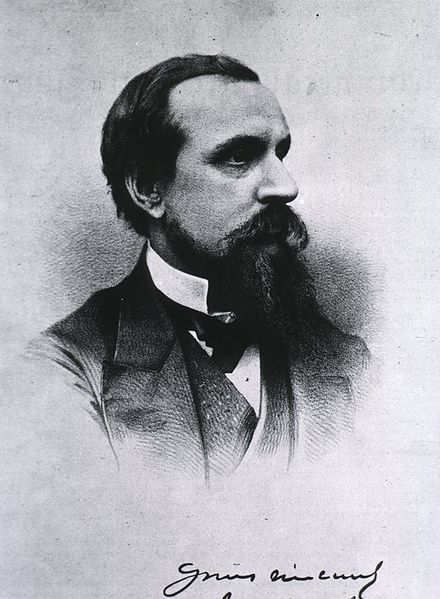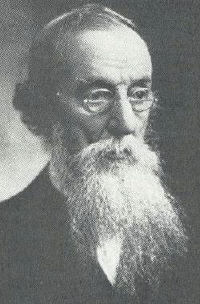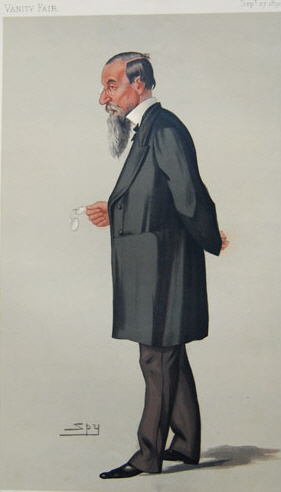<Back to Index>
- Surgeon William Clark, 1828
- Singer Amália da Piedade Rodrigues, 1920
- Field Marshal of the British Army Alan Francis Brooke, 1883
PAGE SPONSOR



Sir Jonathan Hutchinson (23 July 1828 – 23 June 1913), was an English surgeon, ophthalmologist, dermatologist, venereologist and pathologist.
He was born in Selby, Yorkshire, England, of Quaker parents and educated in the local school. After school he was apprenticed for five years to Caleb Williams, an apothecary and surgeon in York.
He entered St Bartholomew's Hospital in London, became a member of the Royal College of Surgeons in 1850 (and a Fellow in 1862), and rapidly gained reputation as a skilful operator and a scientific inquirer. While a student Hutchinson chose a career in surgery from 1854 on, under the influence and help of his mentor, Sir James Paget (1814 – 99). In 1851 he studied ophthalmology at Moorfields and practised it at London Ophthalmic Hospital. Other hospitals where he practised in the following years were the Lock Hospital, the City of London Chest Hospital, the London Hospital, the Metropolitan Hospitals and the Blackfriars Hospital for Diseases of the Skin.
His intense activity in so many medical specialties reflected also in his involvement with several medical societies. He was president of the Hunterian Society in 1869 and 1870, professor of surgery and pathology at the Royal College of Surgeons from 1877 to 1882, president of the Pathological Society (1879 – 80), of the Ophthalmological Society (1883), of the Neurological Society (1887) of the Medical Society (1890), and of the Royal Medical and Chirurgical Society from 1894 to 1896. In 1889 he was president of the Royal College of Surgeons. He was a member of two Royal Commissions, that of 1881 to inquire into the provision for smallpox and fever cases in the London hospitals, and that of 1889 – 96 on vaccination and leprosy. He also acted as honorary secretary to the Sydenham Society. In June 1882 he was elected a Fellow of the Royal Society.
Hutchinson's activity in the cause of scientific surgery and in advancing the study of the natural sciences was unwearying. He published more than 1,200 medical articles and also produced the quarterly Archives of Surgery from 1890 to 1900, being its only contributor. His lectures on neuropathogenesis, gout, leprosy, diseases of the tongue, etc., were full of original observation; but his principal work was connected with the study of syphilis, on which he became the first living authority. He was the first to describe his triad of medical signs for congenital syphilis: notched incisor teeth, labyrinthine deafness and interstitial keratitis, which was very useful for providing a firm diagnosis long before the Treponema pallidum or the Wassermann test were discovered.
He was the founder of the London Polyclinic or Postgraduate School of Medicine; and both in his native town of Selby and at Haslemere, Surrey, he started (about 1890) educational museums for popular instruction in natural history. He published several volumes on his own subjects and was given an Hon. LL.D degree by both the University of Glasgow and University of Cambridge. He received a knighthood in 1908.
Sir Jonathan Hutchinson has his name attached to the following entities in medicine: Hutchinson's angina, Hutchinson's sign, Hutchinson's dehidrosis, Hutchinson's disease or senile degeneration of the choroid, Hutchinson's facies, Hutchinson's freckle (a precancerous spot occurring in old age), Hutchinson's mask, Hutchinson's melanotic disease, Hutchinson's patch (a corneal sign attached to syphilitic keratitis), Hutchinson's prurigo, Hutchinson's pupil, Hutchinson's teeth (seen in congenital syphilis), Hutchinson's triad, Hutchinson - Gilford Progeria Syndrome.
After his retirement from active consultative work he continued to take great interest in the question of leprosy. In one of his few scientific errors, he was firmly convinced that there was a link between getting leprosy and eating salted or rotted fish, even after the pathogenic agent, Mycobacterium leprae was discovered in 1873.
He was the founder of Haslemere Educational Museum.
He died on 23 June 1913, in Haslemere, Surrey. He had married Jane Pynsent West in 1856; they had six sons and four daughters.